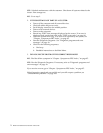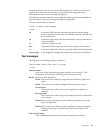
General information 5
• Large system memory
The memory bus in the server supports up to 1.5 gigabytes (GB) of system
memory. The memory controller provides error code correction (ECC) support
for up to three industry-standard PC133, 3.3 V, 168-pin, 133 megahertz (MHz),
unregistered, synchronous dynamic random access memory (SDRAM) dual in-
line memory modules (DIMMs).
• Systems-management capabilities
See the documentation provided with the systems-management software for
more information.
• Integrated network environment support
The server comes with an Ethernet controller on the system board. This Ethernet
controller has an interface for connecting to 10-Mbps or 100-Mbps networks. The
server automatically selects between 10BASE-T and 100BASE-TX environments.
The controller provides full-duplex (FDX) capability, which allows simultaneous
transmission and reception of data on the Ethernet local area network (LAN).
• IBM ServerGuide™ CDs
The ServerGuide CDs included with IBM servers provide programs to help set up
the server and install the network operating system (NOS). The ServerGuide
program detects the hardware options installed, and provides the correct
configuration program and device drivers. In addition, the ServerGuide CDs
include a variety of application programs for the server.
Note: The latest level of BIOS for the server is also available through the World
Wide Web. Refer to “Recovering BIOS” on page 14 for the appropriate
World Wide Web addresses.
Reliability, availability, and serviceability
Three of the most important considerations in server design are reliability, availability,
and serviceability (RAS). The RAS features help to ensure the integrity of the data
that is stored on the server, the availability of the server when needed, and the ease
with which you can diagnose and repair problems.
The following is an abbreviated list of the RAS features that the server supports.
Many of these features are explained in the following chapters of this book.
• Reliability features
— Boot block recovery
— Cooling fans with speed-sensing capability
— Customer-upgradable basic input/output system (BIOS)
— ECC front-side buses (FSBs)
— ECC L2 cache
— ECC memory
— Parity checking on the small computer system interface (SCSI) and peripheral
component interconnect (PCI) buses
— Advanced configuration and power interface (ACPI)
— Power-on self-test (POST)
— Synchronous dynamic random access memory (SDRAM) with serial presence
detect (SPD)
• Availability features
— Advanced desktop management interface (DMI) features
— Alarm on LAN™ capability
– Chassis intrusion
– Operating system (OS) hangs


















